When you check your retirement account statements, what is the first thing you look at? Is it your current account value?
If so, is that number how you currently define your wealth?
Many of us will think about our wealth as the number at the top of our statement. However, this is a “paper” number that fluctuates daily, unless you’re saving or investing for a single, large lump sum purchase, it isn’t the best judgement of your wealth.
What if you could start to define your wealth in a different way?
Today we are going to share with you a clip from recent training videos where Shelley Seagler (Director of Investor Education) shares a unique perspective:
The number that really matters is the actual spendable income, or cash flow, your portfolio can produce. Cash flow is the key.
Cash flow is money that comes to you while you still own the asset. The key characteristic of cash flow is that you do not have to sell the asset in order to make money.
This is because your assets are producing income.
What if you started looking at the assets in your portfolio as the way your bills were going to get paid month after month?
Here is an example:
If your total monthly living expenses are $7,000 a month and your portfolio produces $10,000 a month in cash, you are able to maintain your desired standard of living, keep up with inflation, pay your taxes, and be prepared for emergencies.
What if you defined wealth, not as the number at the top of your account statement, but as the amount of income your assets produce?
So now it’s your turn – how much income would you need your portfolio to produce month after month?
To learn more, be sure to sign up for our next online course updates at SniderMethod.com






